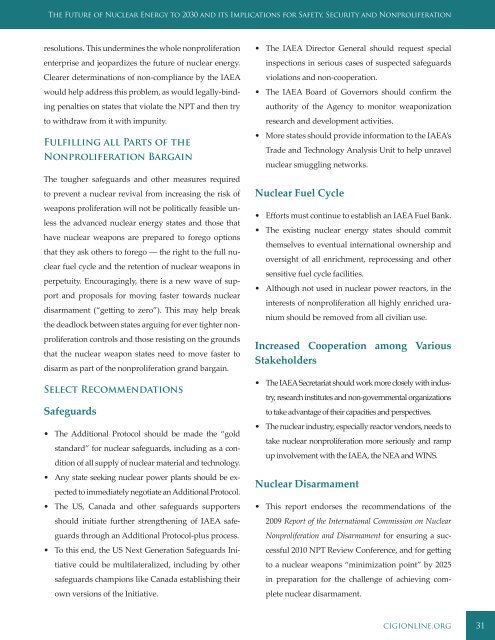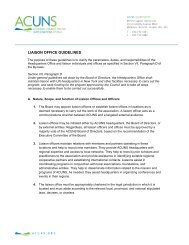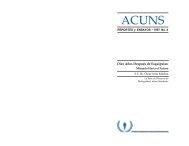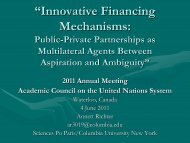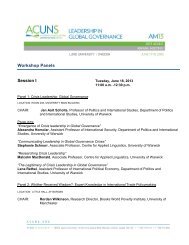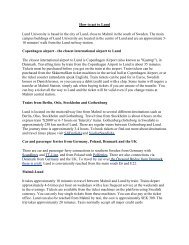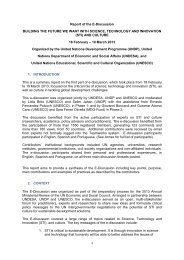THE FUTURE OF NUCLEAR ENERGY TO 2030 AND ITS ... - acuns
THE FUTURE OF NUCLEAR ENERGY TO 2030 AND ITS ... - acuns
THE FUTURE OF NUCLEAR ENERGY TO 2030 AND ITS ... - acuns
Create successful ePaper yourself
Turn your PDF publications into a flip-book with our unique Google optimized e-Paper software.
The Future of Nuclear Energy to <strong>2030</strong> and its Implications for Safety, Security and Nonproliferation<br />
resolutions. This undermines the whole nonproliferation<br />
enterprise and jeopardizes the future of nuclear energy.<br />
Clearer determinations of non-compliance by the IAEA<br />
would help address this problem, as would legally-binding<br />
penalties on states that violate the NPT and then try<br />
to withdraw from it with impunity.<br />
Fulfilling all Parts of the<br />
Nonproliferation Bargain<br />
The tougher safeguards and other measures required<br />
to prevent a nuclear revival from increasing the risk of<br />
weapons proliferation will not be politically feasible unless<br />
the advanced nuclear energy states and those that<br />
have nuclear weapons are prepared to forego options<br />
that they ask others to forego ― the right to the full nuclear<br />
fuel cycle and the retention of nuclear weapons in<br />
perpetuity. Encouragingly, there is a new wave of support<br />
and proposals for moving faster towards nuclear<br />
disarmament (“getting to zero”). This may help break<br />
the deadlock between states arguing for ever tighter nonproliferation<br />
controls and those resisting on the grounds<br />
that the nuclear weapon states need to move faster to<br />
disarm as part of the nonproliferation grand bargain.<br />
Select Recommendations<br />
Safeguards<br />
• The Additional Protocol should be made the “gold<br />
standard” for nuclear safeguards, including as a condition<br />
of all supply of nuclear material and technology.<br />
• Any state seeking nuclear power plants should be expected<br />
to immediately negotiate an Additional Protocol.<br />
• The US, Canada and other safeguards supporters<br />
should initiate further strengthening of IAEA safeguards<br />
through an Additional Protocol-plus process.<br />
• To this end, the US Next Generation Safeguards Initiative<br />
could be multilateralized, including by other<br />
safeguards champions like Canada establishing their<br />
own versions of the Initiative.<br />
• The IAEA Director General should request special<br />
inspections in serious cases of suspected safeguards<br />
violations and non-cooperation.<br />
• The IAEA Board of Governors should confirm the<br />
authority of the Agency to monitor weaponization<br />
research and development activities.<br />
• More states should provide information to the IAEA’s<br />
Trade and Technology Analysis Unit to help unravel<br />
nuclear smuggling networks.<br />
Nuclear Fuel Cycle<br />
• Efforts must continue to establish an IAEA Fuel Bank.<br />
• The existing nuclear energy states should commit<br />
themselves to eventual international ownership and<br />
oversight of all enrichment, reprocessing and other<br />
sensitive fuel cycle facilities.<br />
• Although not used in nuclear power reactors, in the<br />
interests of nonproliferation all highly enriched uranium<br />
should be removed from all civilian use.<br />
Increased Cooperation among Various<br />
Stakeholders<br />
• The IAEA Secretariat should work more closely with industry,<br />
research institutes and non-governmental organizations<br />
to take advantage of their capacities and perspectives.<br />
• The nuclear industry, especially reactor vendors, needs to<br />
take nuclear nonproliferation more seriously and ramp<br />
up involvement with the IAEA, the NEA and WINS.<br />
Nuclear Disarmament<br />
• This report endorses the recommendations of the<br />
2009 Report of the International Commission on Nuclear<br />
Nonproliferation and Disarmament for ensuring a successful<br />
2010 NPT Review Conference, and for getting<br />
to a nuclear weapons “minimization point” by 2025<br />
in preparation for the challenge of achieving complete<br />
nuclear disarmament.<br />
cigionline.org 31


